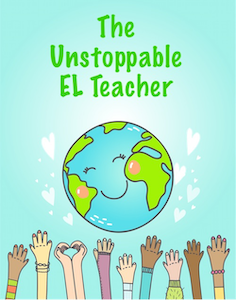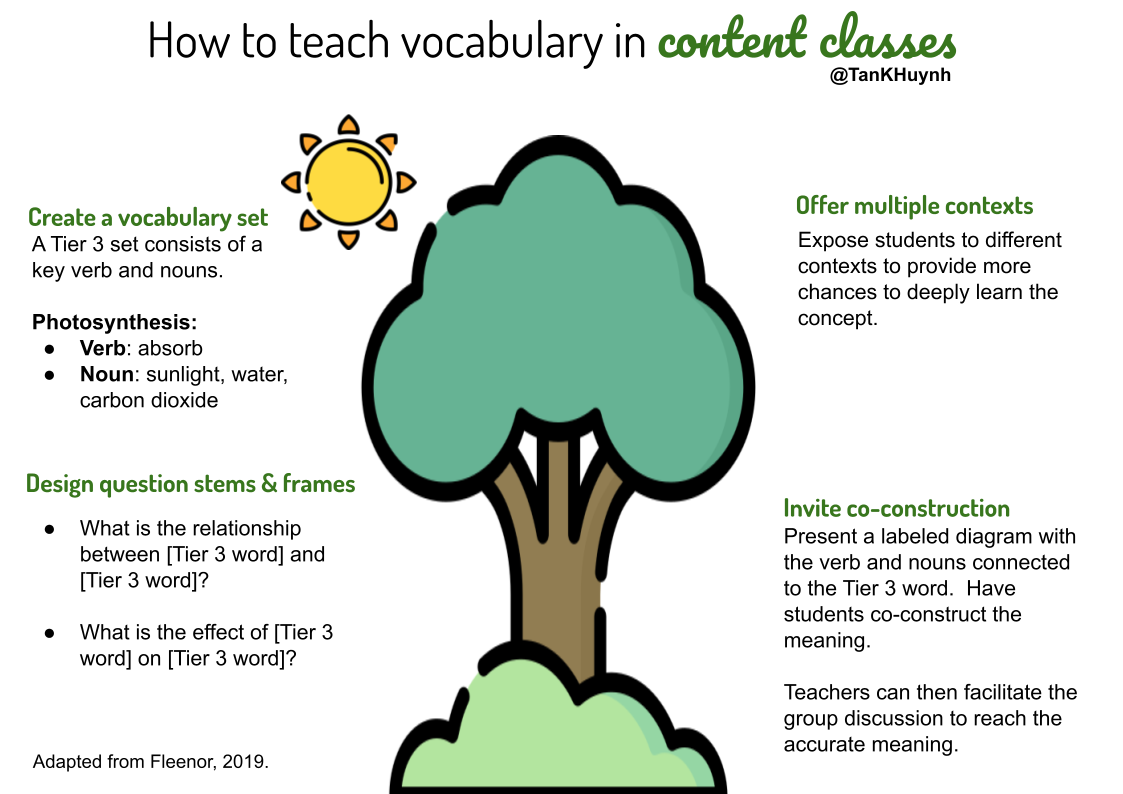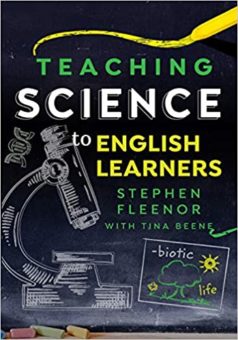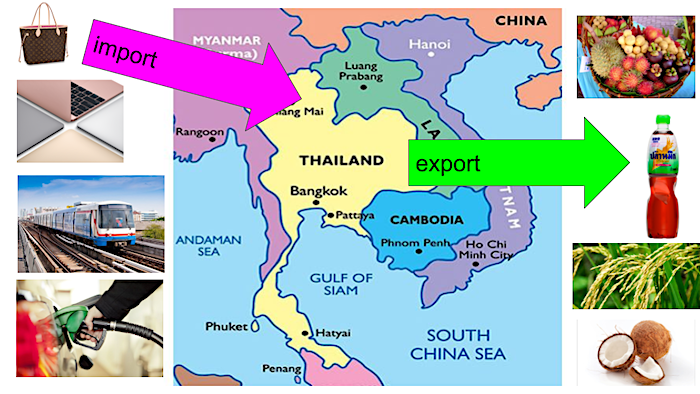How to Teach Content Vocabulary to Our ELs
A MiddleWeb Blog
 A school is an ocean of words. Yet some language learners are drowning in academic classes when content-specific words (Tier 3) are not explicitly taught (Beck, McKeown, & Kucan, 2008).
A school is an ocean of words. Yet some language learners are drowning in academic classes when content-specific words (Tier 3) are not explicitly taught (Beck, McKeown, & Kucan, 2008).
However, there is an effective process to teach these discipline-specific words. Dr. Stephen Fleenor, author of Teaching Science to English Learners (2019), shared an easy-to-implement process for teaching Tier 3 words from any discipline in our November podcast conversation. Here are the highlights.
What not to do
Before we discuss what to do, we have to address ineffective vocabulary instruction. Stephen urges us not to assign a list of 20-30 Tier 3 words taken from the glossary for students to memorize. This does not work because it lacks the context that teaches the words’ meanings.
Additionally, memorizing an extensive list of words is counterproductive because the goal of teaching content vocabulary is application, not coverage or memorization. With a smaller daily list, students are more likely to apply these specialized words correctly during class and afterwards.

Create a vocabulary set
Think about a particular topic or concept (e.g. WWII, ecosystem, human rights, solving for x). Now ask yourself which words need to be taught for students to understand and engage the central concepts. Think of the vocabulary set for a Tier 3 word as a “mini solar system.” The central concept is the sun, and other supporting words orbit around it.
For example, in science, if the target Tier 3 word is trophic cascade, we must teach the following terms as a set first: consume, apex predator, secondary consumer, consumer, and producers. In this solar system of words, trophic cascade is the sun while all the other words orbit around it. These secondary words can be arranged together to help explain the concept of the target word.
A Tier 3 word set usually consists of various nouns and a key verb. The essential verb associated with trophic cascade is consume, which is valuable to teach because it is a word that appears frequently across content areas. We call these Tier 2 words. Tier 3 word sets, then, can pull double duty, teaching Tier 2 and Tier 3 words at the same time.
Invite construction
Stephen recommends giving students a diagram of the target Tier 3 word. Then invite students to construct a meaning of the target Tier 3 word with just the supporting words as clues. To further scaffold the process, label the key elements in the diagram. You could even provide a sentence stem or frame that forces students to use the target Tier 3 word when talking.
 Additionally, you might consider allowing students to co-construct the meaning as a pair or small group, share aloud their ideas, and then come to a consensus on the definition with the teacher’s assistance.
Additionally, you might consider allowing students to co-construct the meaning as a pair or small group, share aloud their ideas, and then come to a consensus on the definition with the teacher’s assistance.
Prompt students to also look at prefixes, roots, and suffixes in the word to help them construct the meaning. In our example, some students might recognize the word cascade, and if they do, they might be able to apply it to their construction of the meaning.
Offer multiple contexts
Focusing on a small set of words allows teachers to expose students to those words in various contexts. Applying the meaning of a Tier 3 word to a different scenario is also a higher order thought process. Through these different contexts, students gain a deeper understanding of the concept through discussion.
For example, you might introduce the term trophic cascade with a killer whale scenario, but in subsequent days, students might learn about trophic cascade in relation to rats in Borneo, wolves in Yellowstone, or lions in Kenya. With each scenario, students form a deeper, fuller understanding of the concept of ecological imbalance.
Design question stems and frames
The goal of teaching Tier 3 words is not just comprehension but also mastery. To help students master the Tier 3 words, create sentence frames and stems that structure their use. Sentence frames and stems support critical thinking. By design, they can help students form connections between words or think about the topic more deeply.
Examples include:
► If the [Tier 3 word #1] was to change, how would this affect [Tier 3 word #2]?
► When [Tier 3 word #1] occurs, what would happen to [Tier 3 word #2]?
► As [Tier 3 word] is occurring, what is produced as a result?
► After [Tier 3 word] occurs, what does this lead to?
In my Grade 6 Geography class, I was teaching students about the concepts of imports and export as they are aspects of Region, which is one of the 5 themes of geography. I used this visual to teach them the concepts. I then would have sentence starters such as:
► Thailand exports [ ] to [ ] because…. (Thailand exports coconut to the United States because their climate is not tropical enough to grow coconuts year round.)
► Thailand imports [ ] from [ ] because … (Thailand imports gasoline from the Middle East because Thailand does not have oil deposits.)
These question stems and frames can be easily converted into answers by taking out the questioning phrases, such as “how would” and “what would happen.” When the stems are declarative instead of interrogative, they add an extra layer of support for students who need it. Remember to only offer the scaffold if students need an extra boost to speak and write in that content-specific register.
Two of Stephen’s favorite stems when responding are:
► The relationship between [Tier 3 word #1] and [Tier 3 word #2] is _____.
►[Tier 3 word #1] affects [Tier 3 word #2] by ____.
Assess Tier 3 words
Design a prompt, exit ticket, or a task that requires the use of the target Tier 3 word (the “sun” word) at the end of the lesson. The response can be spoken, written, or acted out.
There are different levels at which teachers can design the formative assessment. They are:
1. Create: Create a metaphor for the Tier 3 word.
2. Evaluate: Explain what the greatest impact of the Tier 3 word would be if it was increased or decreased.
3. Analyze: Discuss the Tier 3 word’s relationship with something else.
4. Apply: Explain how a particular Tier 3 word would function in a different context.
5. Understand: Provide examples of the Tier 3 word.
6. Remember: Describe the Tier 3 word.
These strategies work across disciplines
Though most of the examples in this article are science-based, the process of using a vocabulary set can be used in any discipline. Stephen’s message is twofold:
► we must explicitly teach Tier 3 words, and
► the key principle behind vocabulary instruction must shift from memorization to application.
By following his model, we not only ensure that language learners master content-specific standards, we also develop their ability to construct meaning and think critically, which are skills they will need for an engaged life beyond the school walls.
References
Beck, I. L., McKeown, M. G., & Kucan, L. (2008). Creating robust vocabulary: Frequently asked questions and extended examples. New York: Guilford Press.
Fleenor, S., & Beene, T. (2019). Teaching science to English learners. Irving, TX: Seidlitz Education.



































